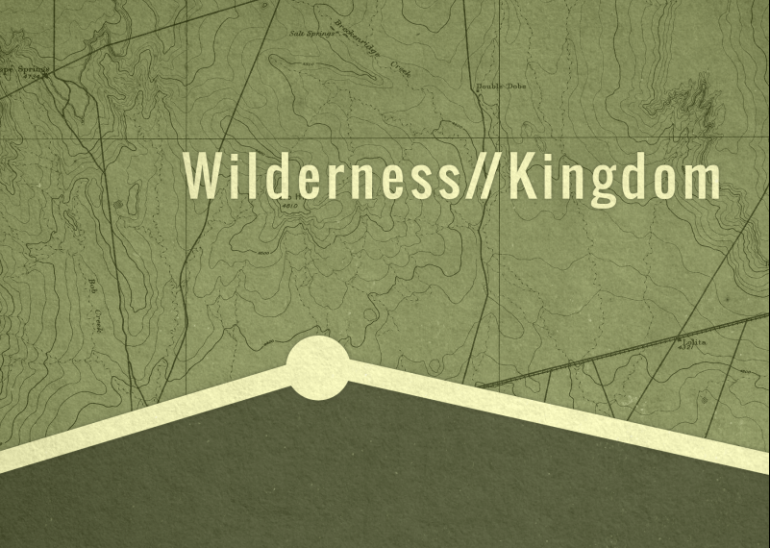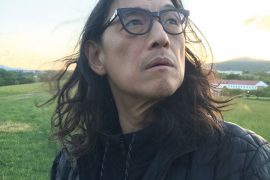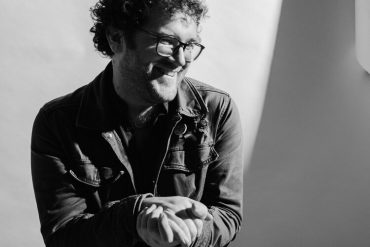Our Interviews Editor Esteban Rodríguez talks with poet Jory Mickelson about their debut collection Wilderness//Kingdom (Floating Bridge Press, 2019) and its explorations of identity, art, and what it means to inhabit a landscape fertile with inspiration.
Esteban Rodríguez: Can you tell us about your book and how Wilderness//Kingdom came to be?
Jory Mickelson: Wilderness//Kingdom came together with a lot of love and editing and other peoples’ belief in the manuscript. As much as I would like to be the sort of writer who writes books or long stretches of poems for a particular project, I am not. I write and the poems accumulate over time. I am also a fairly slow writer.
When I started ordering the poems, I tried several methods. Some helpful advice I received from Eduardo Corral was to try and create movements of three poems that connect in varying ways—a link of language, a shift in tone, a shared image. After you form several triples, see how these small spans can be woven together into larger sections. It allowed me to stay small and not get too overwhelmed.
I sent out the manuscript, in differing forms, across several years. Some years, I just received form rejections (if the contests bothered to contact the entrants at all, but that is another topic entirely). Once or twice I was a finalist or semi-finalist. That gave me hope.
Also, I owe Wilderness//Kingdom‘s existence to my incredible writing group (Hello Madronas!). Our writing group focused on one of our manuscripts on a rotating basis. They made valuable suggestions for shaping W//K, but more important they believed in me and my work. They encouraged me. They said, “Absolutely” to my creative vision. After about five years of sending Wilderness//Kingdom out, I had given up. My writing group, my believing mirrors as Julia Cameron would call them in her The Artist’s Way book, lifted me up. We may write alone, but we need—at least I need—people, fellow writers, a writing community of some kind to carry us through.
My name is on the cover of Wilderness//Kingdom, but there are so many people I have to thank for the book’s reality.
ER: Interesting that you mention the difference between a collection of poetry versus a poetry project (a discussion that seems to be emerging in the poetry community). Your book, nevertheless, centers around similar themes, and in particular it depicts and wrestles with the landscape as much as it does to the bodies that inhabit it. In “Synonym for Wing,” for example, we see the speaker reflect on two men “locked together on the stony / bank” and the interaction that ensues. Can you describe how you approached both the landscape and the body, not only in this poem, but throughout the collection?
JM: I know there has been some muttering against the project poem, but I don’t find anything disagreeable about that. I think that projects are a kind of container or constraint, like form, which helps a poet navigate their obsessions. I will agree that Wilderness//Kingdom does have its themes, obsessions, and recurring issues around land/landscape. Specifically, in “Synonym for Wing,” I was looking for ways to maximize all the damn birds in the collection. I can’t seem to write three poems without two birds finding their way into them. Synonym was an exploration of what would happen if the young boy in the poem were shown what queerness might look like in their own world. In this case, on a river. So many queer people in rural settings can feel incredibly isolated because, on the surface, their lives and landscapes have no queer representation. I certainly never saw queerness in rural Montana. Not until I was old enough to recognize it in myself, but no one was speaking openly about it, it was all rumor, conjecture, and fear.
I am deeply interested in the landscape—the flora and fauna, the geologic features, the watershed—but I am also attentive to what happens to the story of the landscape when it is written over by both public and personal histories. Where I grew up, the Bitterroot Salish were the first recorded people to inhabit the land. In their cosmology, Coyote created the Bitterroot Valley just for them to be a rich, bountiful place. This isn’t my story to tell, but it is one story that is good to know. Another story written on the land is about the coming of Jesuit missionaries, the removal of the Salish, the founding of a small town. Then there are the personal stories of the people who lived, are living, will one day live in that place. Somehow, they are all woven together—past, present, futures—actual or dreamed of.
My poems struggle with habitation, legacy, exile. I think the best way I could describe my approach to landscape would be to call it interpenetrative. The land and the poet overlap in time, space, and imagination. One can hardly be sorted from the other. I may come closest to saying this in my poem “Afterlife,” which ends, “…Hello, said the sea // though it would not recognize itself.”
ER: Your collection includes significant references to art and artists (to Georgia O’Keeffe, for example). In “My Father Drawing My Portrait,” we see how art is used as an attempt to come to terms with the inevitable:
I’m clumsy or too impatient or didn’t watch my father
carefully as he set my own face down because
he will someday be a line that fades, the words to his singing
muted, me beside him in the car pulling onto the road, this
driving, the rising dust, my father’s characteristic marks
on the paper already smudged and vanishing
before he tears out the page – I have to tell you
his face will be erased before I can capture it.
ER: What parallels do you see between art and poetry, and how much does art (and certain pieces of art) influence your work?
JM: Both of my parents are artists and art teachers in the public-school system. I grew up drawing and learning about different artists because those were the books on my parents’ bookshelf. Eight-year-old me was thrilled to discover the work of fantasy and sci-fi artist Frank Frazetta. My grandfather was a Universal Studios monster movie fan, so seeing Frazetta’s Dracula Meets the Wolfman was a chance to braid together familial passions. What I love most today about my childhood worldview is that artists like Frazetta, Michelangelo, O’Keeffe, and Gary Larson all received equal billing. I loved what I loved without apology.
Before I was a poet, I was a visual artist. My first three years at university were as a studio painting major. Proficient though I was, I wasn’t very talented. I also wasn’t passionate about making art. I couldn’t imagine spending 20, 30, 40 hours a week in a studio painting. After three years, I dropped out and waited to see what I really wanted to do with myself.
It took me more than a decade to realize poetry was my passion. I spend hours working on poems. Some of them get picked up and put down for months or years. Reading the work of others always engages me, both for pleasure and learning technique. My studio art training was preparation to become a writer. I don’t regret it.
When I think about poems and speak about them, I use the vocabulary and eye of a visual artist. I think about a poem as a sort of composition. Where is the focal point? Where are the leads guiding the reader/viewer to the focus? What is needed in the foreground? What can remain implied or just beyond the frame?
Individual artists and artwork continue to inspire and challenge me. I still spend hours in museums looking. Poetry has helped me to hone my focus, stretch the length of my gaze. Poetry helps me look at difficult or confusing works of art and remain open to them. Art helps me to see and poetry allows me to hold space for the inner experience looking. As my friend, poet John Myers, wrote me in a letter, “The only steady liberty is looking.”
ER: In the poem “Self-Portrait with Men in Cars,” the speaker refuses to be “framed by anything / but landscape and movement,” eschewing tropes and narratives that would incorrectly define his life. How do you want your collection defined? Or do you think it should be?
JM: Definitions and labels are tricky. They can help people find a common language with which to discuss a subject, but also allow for projection, stereotypes, and dismissal. As far as Wilderness//Kingdom is concerned, it is a work by a queer or LGBTQ author. Because of that, it deals with queer subject matter. Does that make the book a gay book only? I hope not.
We as a culture, are often obsessed with the easy or at least quick answer. Poetry almost always resists the easy, the quick. Poetry unfolds at its own pace, with its own slow wonderings. At its best, poetry serves as an invitation and an entryway for readers. I hope Wilderness//Kingdom serves as an invitation to the reader into sometimes familiar, sometimes strange vistas and territories.
ER: Sending out full-length manuscripts to presses can oftentimes be burdensome, in various ways. Can you explain the process and approach for your collection?
JM: I think that as generous as we try to be about poetry, poetry publishing can send us a different message. We love to share poems on social media, encourage people to buy recently published books, and to read literary journals.
This stands in contrast to an industry that puts the costs of publishing increasingly or entirely on the writer. We know this. As institutional support, subscriptions, and general readership has waned—the costs to keep it all going has fallen on us writers.
It is really expensive to send your manuscript out to contests or to publishers. Almost all require reading or contest fees. A professor told a recent MFA graduate, a friend of mine, that they should plan on budgeting $500-$1000, a year for contest and lit journal fees. Many writers, emerging or not, don’t have that kind of cash to leverage on the hope of getting published. They will also never recoup it.
In the end I had to limit who I sent the manuscript out to. I couldn’t afford to do more than five or six a year. ($36 fee x 6 = $210). I had to budget. This limits my chances of ever having a book published, even if the work is stellar. These are not hopeful realities for poets.
ER: What is currently inspiring you?
JM: There is so much good poetry in the world right now. One thing that I love is that if a group of 12 poets each read 10 really great books of poems, it is possible that none of them read the same books! Also, my writing has been enriched in innumerable ways from poets and poems I discover on my Twitter feed.
Currently, I am inspired by the essays of Mary Oliver. I’ve been methodically reading the essays, which I have not done or given only partial attention to in the past. She has many wise and insightful things to say. Her syntax likes to show off spectacularly at times.
“The sun, angling out from the bunched clouds, cast one could easily imagine tenderly over the landscape its extraordinary light.” (From her book Winter Hours.)
That is such a leggy sentence!
Another way I have been inspired currently is by reading past issues of American Poetry Review. I am a new subscriber this year and have been taking time at my local university library to read back issues of the late 1970s and early 1980s. It’s exciting (can I say that?) to encounter poets I’ve not heard and to read essays. Gerald Stern has an essay called “The Sabbath” from 1984, I think, that knocked me on my ass. It was so good.
ER: If you could describe your poetic journey in a few words, what would they be?
JM: Twisty, late-blooming, obsessive, and fumbling.
ER: What advice do you have to emerging poets, and what advice would you give to your younger self?
JM: Stop worrying. No, seriously. Stop worrying! When I started writing poems I was in my late twenties or early thirties. I thought I had, as James Wright says in his poem, “wasted my life.” There was so much to learn, so much to read, so much to catch up on.
But that is the catch. In my own insecurity and self-doubt, I couldn’t see I was right where I was supposed to be. We all start at the beginning. Sure, there were smarter, better read, and more outspoken people in my classes. The poets I met in town, outside of school, had been published and I had not. I couldn’t see they all started where I was: at the beginning.
It’s okay to be right where you are, dear Jory, and dear poet. It isn’t a race. Your poems will take you where they will take you if you let them. Your poems are nobody else’s. They are yours and they are ready to teach you if you let yourself listen to their whispering.





